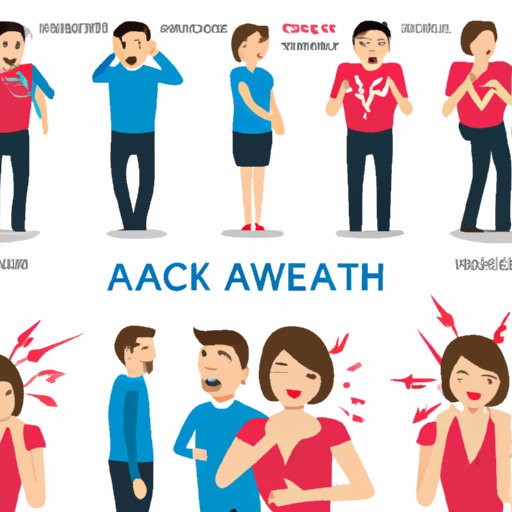
Introduction
Heart attacks, also known as myocardial infarctions, are serious medical emergencies that require immediate attention. They occur when there is a blockage of blood flow to the heart, which can cause significant damage to the heart muscle. Recognizing the symptoms of a heart attack is crucial for timely medical intervention and prevention of serious complications, including death. In this article, we will explore the various symptoms of a heart attack and discuss how to identify and respond to them.
Don’t Ignore the Signs: Recognizing Symptoms of a Heart Attack
One of the most common symptoms of a heart attack is chest pain or discomfort. This pain is often described as a tightness, pressure, or aching sensation in the chest that can spread to the shoulders, neck, jaw, or arms. Some people may also experience nausea, lightheadedness, or sweating, particularly women and older adults. Shortness of breath is another symptom that may occur with chest pain or on its own. It may be accompanied by a feeling of tightness in the chest, or a sense of being unable to catch your breath.
However, it’s important to note that not everyone experiences chest pain during a heart attack. In fact, some people may only have mild symptoms or no symptoms at all. This is why it’s crucial to be aware of other possible symptoms of a heart attack.
Pain or discomfort in other areas of the upper body, such as the back, neck, jaw, or arms, may also be a sign of a heart attack. Some people may also experience indigestion-like symptoms, such as abdominal pain, bloating, or nausea. Others may feel unusually fatigued or weak, or have difficulty performing routine activities due to shortness of breath or chest discomfort.
Know the Warning Signs: How to Identify a Heart Attack
Several risk factors have been identified for heart attacks, including age, gender, family history, smoking, high blood pressure, high cholesterol, diabetes, and a sedentary lifestyle. Men and women may experience different symptoms during a heart attack. Men often experience chest pain or discomfort, while women may experience a variety of symptoms, such as shortness of breath, nausea, vomiting, and back or jaw pain. These differences may contribute to delayed or missed diagnoses in women and older adults.
Age-related differences in symptoms may also occur. Younger individuals, particularly women, may experience less typical symptoms that can be mistaken for other conditions, such as anxiety or panic attacks. Similarly, older adults may be less likely to experience chest pain during a heart attack, and may instead present with symptoms such as confusion, dizziness, or falls.
Body Talk: How Your Body Warns You of a Heart Attack
Recognizing early warning signs of a heart attack can help prevent serious complications. Chest discomfort or pain that occurs with exertion and goes away with rest, for example, may indicate a condition known as angina, which can progress to a heart attack if left untreated. Silent heart attacks, which occur without noticeable symptoms, are also common in older adults and individuals with diabetes.
Family history and genetics may also play a role in the development of heart disease and heart attacks. Individuals with a family history of heart disease or heart attacks are at increased risk, as are those with genetic mutations or disorders that affect the heart.
Be Prepared: Understanding the Symptoms of a Heart Attack
Being aware of the symptoms of a heart attack and knowing when to seek medical attention can save lives. If you or someone you know experiences any of the symptoms described above, call 911 immediately. Don’t wait to see if the symptoms go away on their own, as this can delay critical medical treatment. In the meantime, try to stay calm and keep the person comfortable, while avoiding any physical activity or strenuous exertion.
Individuals at high risk for heart disease, such as those with a family history or existing medical conditions, should also be mindful of the warning signs of a heart attack and take steps to prevent heart disease, such as quitting smoking, eating a healthy diet, exercising regularly, and managing stress.
Listen to Your Heart: Identifying the Symptoms of a Heart Attack
It’s important to note that some conditions, such as panic attacks, anxiety disorders, or gastrointestinal issues, may mimic the symptoms of a heart attack. This can make it difficult to self-diagnose, so it’s important to seek medical attention if you are unsure. Your healthcare provider can conduct tests to determine the cause of your symptoms and provide appropriate treatment.
In conclusion, recognizing the symptoms of a heart attack is crucial for timely medical intervention and prevention of serious complications. By being aware of the warning signs and taking steps to prevent heart disease, individuals can take control of their heart health and reduce their risk of heart attack and other cardiovascular diseases.
Final Words
If you’re concerned about your heart health, talk to your doctor. Together, you can assess your risk and take steps to keep your heart healthy and strong. Remember, recognizing the symptoms of a heart attack and taking prompt action can save lives. Don’t ignore the signs – listen to your body and take control of your heart health today.




